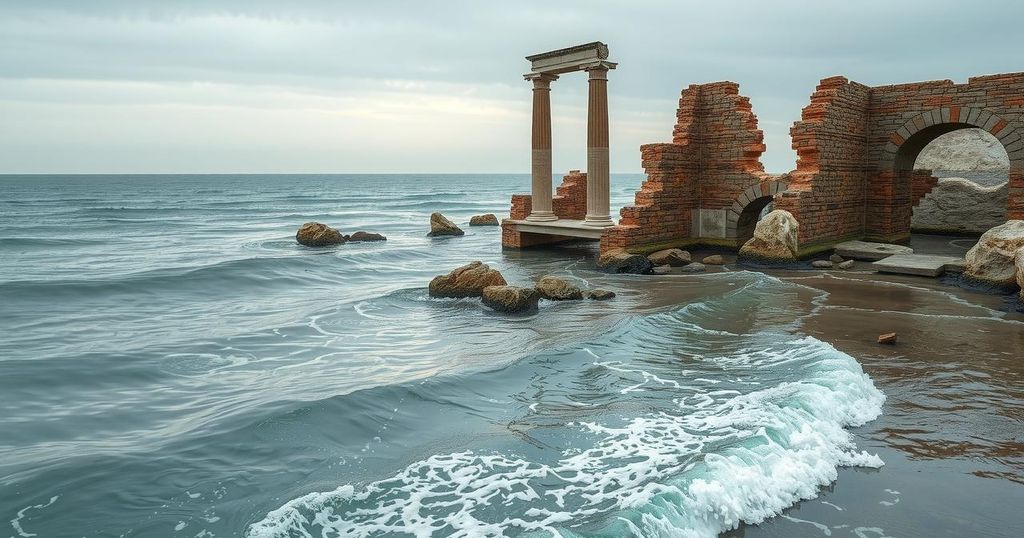A study reveals that Alexandria, Cleopatra’s birthplace, is facing a dramatic increase in building collapses due to rising sea levels and coastal erosion. The occurrence of collapses has surged from approximately one per year to 40 annually over the past decade. Approximately 7,000 older buildings are at risk, prompting researchers to propose the creation of protective sand dunes and vegetation to safeguard the urban coastline.
Recent research indicates that Alexandria, the historic birthplace of Cleopatra, is witnessing a significant rise in building collapses, closely associated with coastal erosion and increasing Mediterranean Sea levels. The study conducted by the University of Southern California revealed that the frequency of building collapses has surged from approximately one per year to 40 annually over the past decade due to rising sea levels and seawater intrusion affecting the city’s foundations.
Founded more than two millennia ago by Alexander the Great, Alexandria is among the oldest cities globally and has grown into one of Africa’s most populous urban centers, housing around 6 million residents. The city is perilously vulnerable to the repercussions of sea level rise, which jeopardizes its rich historical heritage. Modern buildings sit alongside ancient structures erected by various dynasties throughout history, creating a complex urban environment that is now at risk due to climate change.
Despite enduring natural disasters such as earthquakes and tsunamis, Alexandria’s ancient structures are increasingly threatened by rising sea levels and intensifying storms. Sara Fouad, the lead author of the study, commented that these environmental changes are “undoing in decades what took millennia of human ingenuity to create.” The research examined the shoreline’s evolution, utilizing a digital map of collapsed buildings developed from a variety of sources, including satellite imagery and historical data.
The study’s methodology included mapping the locations and conditions of collapsed buildings, dating back two decades to 2001. Additionally, soil isotope analysis helped the researchers understand the effects of seawater intrusion on local infrastructure, revealing that the underlying soil and building foundations were being eroded due to rising groundwater levels. Essam Heggy, a co-author of the study, emphasized that even minor increases in sea levels can have significant negative consequences.
Approximately 7,000 older buildings in Alexandria are now at an elevated risk of collapse. A recent incident in the Wardiyan neighborhood resulted in the deaths of four individuals when a building collapsed, while a separate collapse of a tourist-frequented 14-story structure has raised concerns about groundwater damage influencing such tragedies, as noted by Sara Fouad.
To mitigate these risks, researchers have proposed the establishment of sand dunes and vegetation along the coastline to combat seawater encroachment, offering a sustainable and cost-effective solution applicable to similar urban coastal areas worldwide. Steffen Nijhuis, a co-author of the study, remarked that this approach could serve as a model for protecting densely populated coastal regions internationally.
Alexandria’s challenges with rising sea levels and coastal erosion are not isolated phenomena, as other Mediterranean cities and parts of California are facing comparable threats. Essam Heggy stated that the findings challenge the notion that significant changes will only occur with a one-meter rise in sea levels, highlighting ongoing shifts in coastlines that contribute to unprecedented rates of building collapses worldwide.
In conclusion, the research underscores the urgent need to address the impacts of climate change on coastal cities like Alexandria, as rising sea levels and increased storm activity threaten historical structures and the safety of residents. The proposed solutions highlight potential strategies for mitigating these effects, emphasizing the importance of proactive measures to safeguard both urban infrastructure and cultural heritage. With many coastal communities at risk globally, addressing these challenges is paramount for sustainable urban development.
Original Source: www.cnn.com






